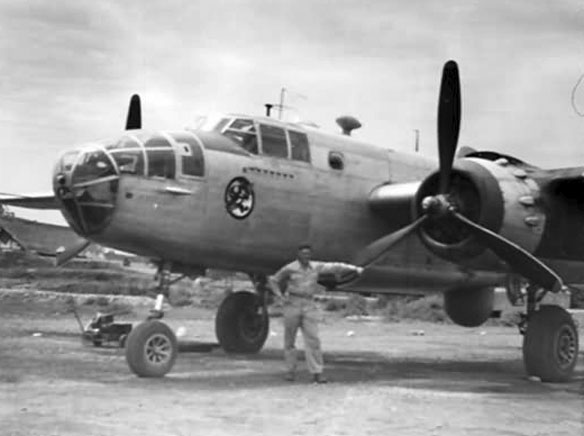During World War II, the United States and Great Britain divided the world into five theaters of operation. The China, India, Burma theater was one of these. General Joseph Stilwell was the American commander. The decision was made in early 1942 to help supply the Chinese with as much military material as possible to fight the Japanese on Chinese soil. To accomplish this goal a special unit of volunteers would be trained to invade Burma.
Compiled as told to Michael H. Pazeian.
I was in San Pedro in 1941. If you were drafted you got $21 a month, if you joined you got $30 a month. So, I joined. I had no basic training. After a week or so I was part of a group sent to Missouri.
Jefferson Barracks was just south of St. Louis on the Mississippi River. We were given mental tests, I scored high, 122 with just high school. Anything under 100 you were Army infantry. I was given the choice of military service. I choose the Air Force and was sent to Chanute Field, Illinois.
I was trained to become an aircraft mechanic. Lots of bookwork and actual working on aircraft engines. I was there for five months. We were sent to Felts Field, Spokane, Washington to be shipped overseas. While in Spokane many were being sent to Europe to work on four engine bombers. They asked if anyone wanted to work on P-38s. I volunteered with 12 others. I knew the P-38s were built in Burbank. I became part of the 9th Photographic Reconnaissance Squadron.
On the 18th of May 1942, our squadron departed Felts Field by train for Charleston, South Carolina. On the 27th of May we boarded the S.S. Mariposa. Our destination remained secret. On the 31st of May the Mariposa anchored in the harbor at Bermuda but sailed again in the early afternoon. After stops in Sierra Leone and Cape Town, South Africa (we had three days of shore leave, we had met a few girls, planned a picnic, but shipped out) the Mariposa docket at Karachi, India, 58 days after leaving Charleston. We got to India on Jul. 24th.
For the next few months we worked on P-66 Vulcans which were used by and for the Chinese. During this time many of the guys would go into town on the weekends. A buddy of mine and I usually stayed on base. We had fun racing the P-66s on the ground from one end of the field to the other and back. We didn’t fly them. Our P-38 planes had been shipped separately, arriving in September. By the time we saw them they were mostly junk. The maintenance crews did not have the proper tools to reassemble the planes. And many had not been properly prepared for the voyage overseas.
They asked the group for volunteers to transfer to the photography unit. I volunteered. I had to learn everything about the cameras. And the photo plane was a B-25 Mitchell (the same bomber used by James Doolittle to bomb Japan in April 1942). There was one 24-inch camera in the belly and two 12-inch cameras on each side of the aircraft. The photo B-25 was striped of all guns and much of its armament to lighten the weight. It was a very simple job.
I became the line chief for the photo operation. Most of the time our planes flew in support of the British during 1942 and early 1943. The new P-38s arrived late in 1943. Our base of operations moved east getting closer to Burma each time. First to Chakulia Air Base, then Pandavewar Air Base, finally in January of 1944 to Barrackpore, India.
At times we had fun. There was a British radar base nearby. Lots of British woman service personnelwere there. One of the women was the only officer. I got to know her. She was much older than I was, and older than most of the other women. Because of her rank she ate and did most things alone. I called her mom. After that she became mom to everyone and people liked her. There were volleyball and baseball games. Dinners and picnics, and dancing.
One time I wanted to go hunting into the jungle. I taped my pant legs to keep the leeches off my skin. I carried a 30-caliber rifle. It was a “pea shooter,” not very big or powerful for what out in the jungle. I saw tiger tracks. I moved into a swampy area. And it was getting dark. I spotted a deer and shot it. Thinking the deer or I could be dinner for the tiger, I picked up the deer and headed back to the base as fast as I could. Often, we had a fish fry for our dinner. We would use explosives in a calmer part of the river to kill the fish. It was an easy and fast way to fish.
On another occasion I got to participate in a Drag race. One of our pilots rebuilt a P-38 out of old and new parts. He made some modifications to his liking which made this Lightening very fast. I was with him as the camera man on a flight. On our way back, he decided to stop at a British base to refuel (a common practice). The British pilots saw us and made a statement about how fast their new British Spitfire was. The race was on. The Spitfire took off first. Then we gave chase. In a very short time our P-38 flew by the Spitfire like it was standing still. We were both laughing.
It was late February 1944. On the B-25 the big camera was placed in the hatch where we crawled into the plane. Once the crew was onboard, the camera was placed. We would take off, once over our assigned area, the pilot radioed “ready”, then radioed, “start”. I operated the camera. The plane flew a pattern over the jungle in Burma. Then the pilot said “stop”. I then took the film canister off the camera, attached a parachute to it. The plane dropped to tree top level. I opened the hatch and dropped the canister as the pilot told me too.
The 5307th Composite Unit with the code name Galahad was put together and trained during 1943. All soldiers and officers received special jungle training: “scouting and patrolling, stream crossings, weapons, navigation, demolitions, camouflage, small-unit attacks on entrenchments, evacuation of wounded personnel, and the then-novel technique of supply by airdrop.” Lt. Col. John George. General Joseph Stilwell picked Frank Merrill to lead the group. Almost 3000 men, officers, equipment, and mules were parachuted into the Burma jungle in February 1944. By May they had engaged and defeated the Japanese in many small and large actions. The major Japanese air base at Myitkyina fell providing the Americans with a much-needed air base for future operations.
Between late February and May of 1944, I flew 26 “secret combat missions”. It was only much later I learn we were providing Merrill’s Marauder’s with vital intelligence for their fight against the Japanese. Most of the time our base was very hot. As we flew into higher altitudes it would get very cold. We put on heavy clothing to protect us. Sometimes in rough air, I got sick. We had oxygen for the higher altitudes. Our crew consisted of the two pilots, the radio operator, and me. A few times we landed at Kunming, China to refuel.
In late November 1944 our Squadron moved to Myitkyina North Airfield, Burma. Operations continued to support the Americans and Chinese, just before I was on my way home after 32 months of service.




